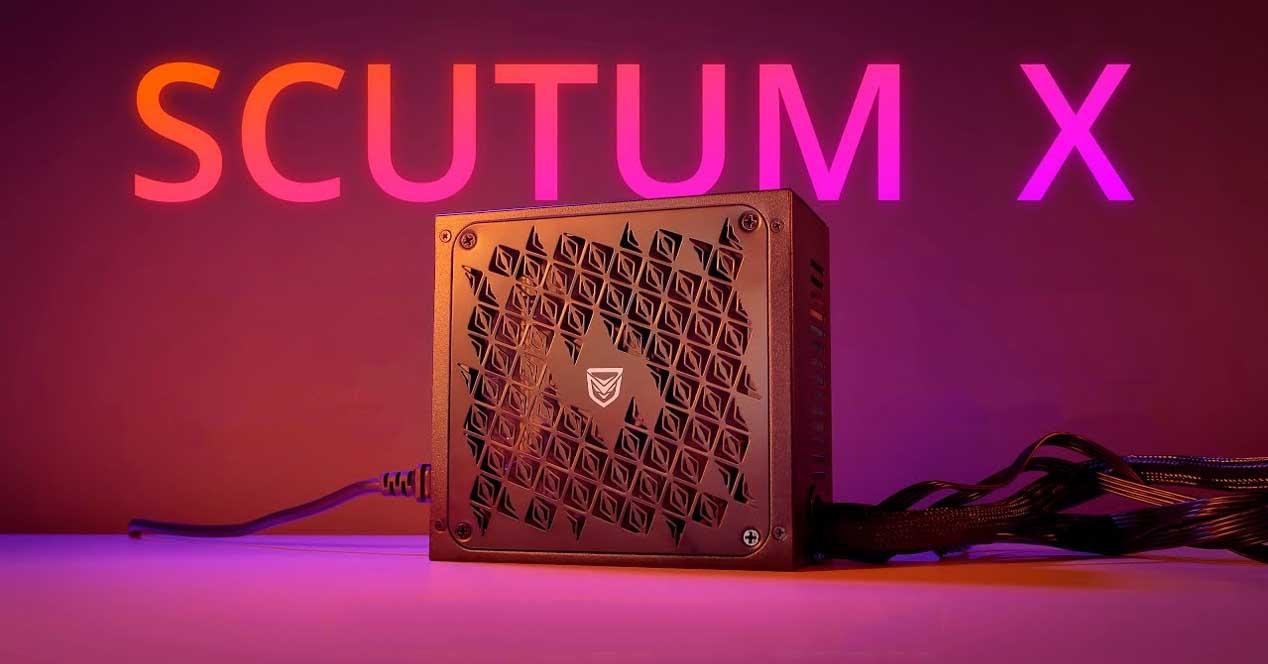It is also worth noting the fact that Nfortec has installed in this power supply a huge 140mm fan in diameter, responsible for keeping the internal components always fresh. This fan has PWM operation, which means that its speed will increase as the device heats up to maintain a good balance between temperature and noise.
Unboxing and external analysis
The 850W Nfortec Scutum X SemiMod comes packaged in a red and black hard cardboard box, on the main side of which we can see an image of the source accompanied by the logo of its efficiency certification, name and model.
On the back we find all the information about the device, including its power supply table, the cables and their length, the connectors and the dimensions of the device.
On the sides we find nothing else of interest except for the usual QR which will send us to the product page on the manufacturer’s website, so we will continue to see what we find inside . Nfortec includes a card with another QR for its instruction manual, a power cable with European plug and four screws to anchor the source to the PC.
All modular cabling is also included, which in this case consists of a cable with two MOLEX connectors and a floppy disk, two cables with three SATA connectors each, and two cables each with an 8-pin PCIe connector.
There are no more “accessories”, so here you have the Nfortec Scutum X SemiMod straight out of the box. Its aesthetic appearance is quite striking thanks to the curious metal grille that protects the fan.
On one of the sides we have a sticker with the brand and model, as well as some ventilation grilles below. On the opposite side we have another sticker, this time with the power table.


On the back we have the usual honeycomb grille, along with a mechanical on/off switch and the 3-pole power cord connector.
On the opposite side we have the output of the fixed cables, as well as the connectors for the perfectly identified modular cables.
The lower part of the fountain is dominated by the huge metal grid, with the brand logo in the center.
Finally, the upper face is completely empty.
By the way, before you complete the external scan, here you can see the connectors that are attached to the source. We needed an additional EPS connector to be able to use this power supply on high-end motherboards.
Internal analysis
To access the inside of this power supply, you must first remove the four screws that secure the metal grille.


Then you have to remove four more screws and we can remove the outer casing which already gives us access to the interior, but not without first removing the fan from above.
The fan is 140mm, with 11 relatively thin but fairly stiff blades, which should not only generate good airflow, but also some pretty compelling static pressure. You can see that the center of the rear part of the fan, where its motor is, has a “glob”…this is not to cover the mark, but to act as insulation as a precaution, as this area may touch internal components. .


Let’s now move on to the analysis of the interior of this Scutum X SemiMod from Nfortec.
Here we have the initial input filter, where we have two Y capacitors and even a case with a protection relay. Although the solders are good here, the truth is that we find them a bit insufficient to support the weight of the assembly, we would have preferred to see a sister board here.
The ground connection connects the input filters directly to the power supply box.
This 850W model incorporates two main condensers which, even if it does not look like it, are of the Japanese brand Teapo, Japanese brand Tier 1 condensers which are resistant to 105ºC and offer an excellent guarantee of operation. This is the same brand used by other well-known manufacturers, such as be quiet! for example.
The modular connection panel has a small PCB, where we now find excellent quality welds.
In the following image you can see the electronics responsible for transforming DC-DC current (ie from 12V DC to +5V and +3.3V), this time in a sister board.
You can also see part of the heatsink and the system of MOSFETs and diodes for power factor correction.
This is the main transformer, responsible for transforming alternating current into direct current so that it can be used by the PC hardware.
Finally, here are the control coils for voltage sensing, the C capacitors which are part of the protection circuit, the secondary transformer for 5Vsb and 12Vc, and the input filter for the main +12V rail.
Overall, the interior of the Scutum X SemiMod is a bit chaotic in the sense that the components aren’t too organized. The solders are excellent in places but perhaps lacking on the input filters, and we think the manufacturer has overused these isolating “globes” a bit, indicating that the components may be too close together and would have had to go for a larger one for this power (look at the first photo in this section, where you can clearly see that the main PCB doesn’t reach the ends of the case).
Overall the interior is okay and we don’t see any flaws or signs of poor quality anywhere.
Scutum X benchmarks
To test this power supply, we used our usual Intel Alder Lake-S platform, consisting of the following hardware:
- Intel Core i9-12900K.
- Be quiet! Pure Rock 2 FX
- 2×16 GB CORSAIR DOMINATOR PLATINUM RGB DDR5 5.200 MHz
- Heroes ASUS ROG MAX Z690.
- TeamGroup Cardea A440 Pro 2TB.
- Gigabyte RTX 3070 Ti gaming.
This equipment has a maximum theoretical consumption of about 600 watts, so it is not unreasonable to use an 850W power supply to have a margin.
Before starting our own tests, we will see, as usual, the official data of the certification entity 80 Plus…. and you will be left speechless. We start by looking at the efficiency graph, where the Scutum X SemiMod shows that it is more efficient the less the equipment consumes, but even so it shows us incredible values that exceed 90% efficiency… and c is 80 Plus Bronze!
In the following graph we can see the power delivered versus the power consumed. The smaller the red zone, the less energy is wasted as heat, and the better for us.
In the following table you can see the empirical tests of efficiency at different load levels.
As we can see, at 10% load this power supply already provides efficiency values above 87%, which will be what we will have with the equipment at rest. But, as soon as we start to “give the cane” to the PC and the consumption begins to climb, we come across yields even higher than 91% at 20% load and almost 91% at 50% load. Then, as we saw in the initial graph, the efficiency drops to 86% at 100% load.
These values are impressive for an 80 Plus Bronze font, and Nfortec could easily have certified it with a superior seal.
Now let’s move on to our own tests, and for this we used OCCT in its latest version with a maximum load of 10 minutes (CPU and GPU). This is the result obtained.
As you can see, this Scutum X SemiMod is unfazed by the test PC at its maximum, and all rails remain completely stable.
In fact, we can see here in the highs and lows, that the +12V rail always stays between exactly 11.904V and 12V, while the +5V is always between exactly 5.04 and 5V and the +3, 3V is between 3.392 and 3.408V, maybe a bit high but certainly with admirable stability.
Conclusion and judgment
After testing the behavior and operation of this 850W Nfortec Scutum X SemiMod, we can only say that it surprised us to the point of leaving us almost speechless. Really, when we see that it is a power supply for 80 Euros and with the 80 Plus Bronze efficiency certification, we do not expect it to be much, especially being semi-modular and with a slightly chaotic interior as we have seen in the analysis.
But then you hook it up to the PC and you see that its rails are extremely stable and its efficiency is way, way better than the efficiency certification seal it bears suggests, so of course it looks like you Purchased a higher-end food source than you first thought…and maybe you did.
The fact that it’s semi-modular doesn’t bother us at all, because in the end the ATX and EPS connectors are going to be used yes or yes, so you’ll have to connect it anyway. What we find fault with is that to be an 850 watt power supply it only has one 4+4 pin EPS connector, while most modern boards already require two such connectors… it’s a shame, and we really don’t. I don’t understand how Nfortec didn’t add extra connectors, but hey.
In any case, we think that this source is quite good, efficient and reliable, and for this reason we award it our gold medal, as well as our recommendation for its very good price/performance ratio.


Table of Contents
































